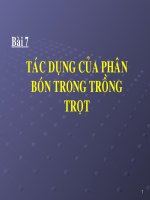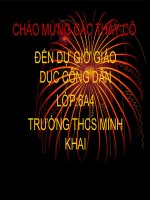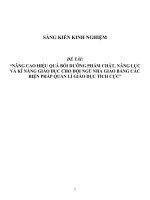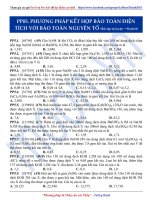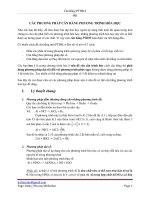Luyện chuyên sâu ngữ pháp và bài tập tiếng anh 6 tập 1 bản WORD
Bạn đang xem bản rút gọn của tài liệu. Xem và tải ngay bản đầy đủ của tài liệu tại đây (2.36 MB, 100 trang )
Unit 1: MY NEW SCHOOL
A – VOCABULARY
New word
activity (n)
Meaning
Hoạt động
Picture
Example
Playing football is one of popular
/ækˈtɪv.ə.ti/
activities at break time
Boarding school (n) Trường nội trú
Students often live and study in a
/ˈbɔː.dɪŋ skuːl/
boarding school
Classmate (n)
Bạn cùng lớp
my classmates
/ˈklɑːs.meɪt/
compass
I often share my school things with
(n)
/ Com-pa
I use a compass to draw circles
ˈkʌm.pəs/
Creative (n)
Sáng tạo
Creative students really like painting.
Thiết bị
Her
/kriˈeɪ.tɪv/
Equipment (n)
school
has
much
modern
equipment
/ɪˈkwɪp.mənt/
Excited (adj)
Phấn chấn, phấn
/ɪkˈsɑɪ·tt̬ɪd/
khích
I'm really excited at studying abroad
www.minh-pham.info
Greenhouse
(n) / Nhà kính
Many schools have greenhouses
ˈɡriːn.haʊs/
International (n) / Quốc tế
In international schools, students
ˌɪn.təˈnæʃ.ən.əl/
learn and speak English every
day
Interview (n)
Phỏng vấn
in the afternoon.
/ˈɪn.tə.vjuː/
Knock (v)
Gõ cửa
Tới nước ngoài
Tiền tiêu vặt
Bài thơ
/səˈraʊnd/
She read the poem aloud to the
class.
/ˈpoʊ.əm/
Surround (v)
His parents give him pocket money
every week.
/ˈpɒk.ɪt ˈmʌn.i/
Poem (n)
They have one overseas holiday a
year
/ˌəʊ.vəˈsiːz/
Pocket money (n)
Someone is knocking loudly at
the door
/nɒk/
Overseas (adj, adv)
He has an interview with Samsung
Bao quanh
My school is surrounded by
mountains
www.minh-pham.info
B- GRAMMAR
I- Thì Hiện Tại Đơn (The present simple )
1. Cách dùng
Dùng để diễn tả thói quen hoặc những việc thường xảy ra ở hiện tại
VD: We go to school every day
Dùng để diễn tả những sự vật, sự việc xảy ra mang tính quy luật
VD:This festival occurs every 4 years
Dùng để diễn tả các sự thật hiển nhiên, một chân lý, các phong tục tập quán, các hiện tượng tự
nhiên
VD:The earth moves around the Sun
Dùng để diễn tả lịch trình cố định của tàu, xe, máy bay.
VD:The train leaves at 8 am tomorrow
2. Dạng thức của thì hiện tại đơn
a. Với động từ “tobe” (am/ is/ are)
Thể khẳng định
I
He/
am
she/
danh từ không
He/
+ danh từ/ tính
từ
You/we/ they/
số
am not
she/
it/
Danh từ số ít/
is
đếm được
từ
I
it/
Danh từ số ít/
Danh
Thể phủ định
danh từ không
is not/ isn’t
+ danh từ/ tính
đếm được
từ
You/we/ they/
are
Danh
từ
số
are not/ aren’t
nhiều
nhiều
Ví dụ:
Ví dụ:
I am a student
I am not here
She is very beautiful
Miss Lan isn't my teacher
www.minh-pham.info
We are in the garden
My brothers aren't at school.
Thể nghi vấn
A
Câu trả lời ngắn
I
Yes,
m
I
am
+ danh từ/ tính No,
am not
He/ she/ it/ Danh từ số ít/ từ
Yes,
He/ she/ it/ Danh từ số ít/ is
danh từ không đếm được
No,
danh từ không đếm được
Ar
You/we/ they/ Danh từ số
Yes,
You/we/ they/ Danh từ số are
e
nhiều
No,
nhiều
Is
isn't
aren’t
Ví dụ:
•
Am I in team A ?
=> Yes, you are./ No, you aren't.
•
Is she a nurse?
=> Yes, she is./ No, she isn't.
• Are they friendly?
=> Yes, they are./ No, they aren't.
Lưu ý:
Khi chủ ngữ trong câu hỏi là “you” (bạn) thì câu trả lời phải dùng “I” (tôi) để đáp lại.
b. Với động từ thường (Verb/ V)
Thể khẳng định
Thể phủ định
I/ You/ We/ They/ + V nguyên mẫu
I/ You/ We/ They/ + do not/ don’t
Danh từ số nhiều
Danh từ số nhiều
He/ she/ it/ Danh + V-s/es
He/ she/ it/ Danh + does not/ doesn’t
từ số ít/ danh từ
từ số ít/ danh từ
không đếm được
không đếm được
+ V nguyên mẫu
www.minh-pham.info
Ví dụ:
Ví dụ:
I walk to school every morning.
They don't do their homework every afternoon.
My parentsplay badminton in the
His friends don't go swimming in the evening
morning.
He doesn't go to school on Sunday
She always gets up early.
Her grandmother doesn't do exercise in the park
Nam watches TV every evening.
Thể nghi vấn
I/
Do
You/
Câu trả lời ngắn
We/
Yes,
They/ Danh từ
No,
số nhiều
He/
Does
she/
it/ +
V
nguyên
Yes,
Danh từ số ít/ mẫu
danh từ không
đếm được
I/
You/
We/ do
They/ Danh từ
số nhiều
He/
she/
it/
don’t
does
Danh từ số ít/
No,
danh từ không doesn’t
đếm được
Ví dụ:
Do you often go to the cinema at weekends?
=> Yes, I do./ No, I don’t.
Does he play soccer in the afternoon?
=> Yes, he does/ No, he doesn’t
Do they often go swimming?
=> Yes, they do/ No, they don’t.
c. Wh- questions
www.minh-pham.info
Khi đặt câu hỏi có chuswas Wh- word (từ để hỏi) như Who, What, When, Where, Why, Which, How, ta
đặt chúng lên đầu câu. Tuy nhiên, khi trả lời cho dạng câu hỏi này, ta không dùng Yes/ No mà cần đưa ra
câu trả lời trực tiếp.
• Cấu trúc
Wh-word + am/is/are + S?
Wh-word + do/ does + S + V?
Ví dụ:
Ví dụ:
Who is he?
What do you do?
=> He is my brother.
=> I am a student.
Where are they?
Why does he cry?
=> They are in the playground.
=> Because he is sad.
3. Dấu hiệu nhận biết
Trong câu ở thì hiện tại đơn thường có các trạng từ chỉ tần suất và chúng được chia thành 2 nhóm:
Nhóm trạng từ đứng ở trong câu:
- Always (luôn luôn) usually (thường xuyên), often (thường), sometimes (thỉnh thoảng), rarely
(hiếm khi), seldom (hiếm khi), frequently (thường xuyên), hardly (hiếm khi), never (không bao
giờ), regularly (thường xuyên)…
Các trạng từ này thường đứng trước động từ thường, đứng sau động từ “tobe” và trợ động từ
Ví dụ:
- He rarely goes to school by bus
- She is usually at home in the evening
- I don’t often go out with my friends
Nhóm trạng từ đứng ở cuối câu:
- Every day/ week/ month/ year (hàng ngày/ hàng tuần/ hàng tháng/ hàng năm)
- Once (một lần), twice (hai lần), three times (ba lần), four times (bốn lần)…
www.minh-pham.info
• Lưu ý:
Từ “ba lần” trở lên ta sử dụng: số đếm + times
Ví dụ:
- He phones home every week
- They go on holiday to the seaside once a year.
4. Cách thêm s/es vào sau động từ
Trong câu ở thì hiện tại đơn, nếu chủ ngữ là ngôi thứ 3 số ít (He/ She/ It/ Danh từ số ít) thì
động từ phải thêm đuôi s/es. Dưới đây là các quy tắc khi chia động từ
Thêm “s” vào đằng sau hầu hết các Ví dụ:
Work-works
Read-reads
động từ
Love- loves
See - sees
Thêm “es” vào các động từ kết thúc Ví dụ:
Miss- misses
Watch- waches
bằng “ch, sh, x, s, z, o”
mix- mixes
Go - goes
Đối với những động từ tận cùng là Ví dụ:
Play- plays
Fly-flies
Buy-buys
Cry- cries
Pay - pays
Fry- fries
“y”
+ Nếu trước “y” là một nguyên âm
(u,e,o,a,i)- ta giữ nguyên “y” + “s”
+ Nếu trước “y” là một phụ âm, ta
đổi “y” thành “i” + “es”
Trường hợp ngoại lệ
Ví dụ:
Have - has
BÀI TẬP VẬN DỤNG CƠ BẢN
Bài 1: Hoàn thành bảng sau, thêm đuôi s/es vào sau các động từ sao cho đúng
V
V-e/es
V
Ve/es
Have (có)
Know (biết)
Do (làm)
Take (lấy)
Say (nói)
Think (nghĩ)
www.minh-pham.info
Get (được)
Come (đến)
Make (làm)
Give (cho)
Go (đi)
Look (nhìn)
See (nhìn thấy)
Use (dùng)
Find (tìm thấy)
Need (cần)
Want (muốn)
Seem (hình như)
Tell (nói)
Ask (hỏi)
Put (đặt)
Show (hiển thị)
Mean (nghĩa là)
Try (cố gắng)
Become (trở thành)
Call (gọi)
Leave (rời khỏi)
Keep (giữ)
Work (làm việc)
Feel (cảm thấy)
Bài 2: Đặt các trạng từ chỉ tần suất vào vị trí đúng ở câu
1. He plays golf on Sundays (sometimes)
_________________________________________
2. The weather is bad in November. (always)
_________________________________________
3. We have fish for dinner. (seldom)
_________________________________________
4. Peter doesn’t get up before seven. (usually)
_________________________________________
5. They watch TV in the afternoon (never)
_________________________________________
6. My brother, Tony, is late for interview. (rarely)
_________________________________________
www.minh-pham.info
7. He helps his father (always)
_________________________________________
8. How do you go shopping? (often)
_________________________________________
9. I don’t do my homework after school (hardly)
_________________________________________
10. The school bus arrives at seven. (every day)
_________________________________________
Bài 3: Viết các câu sau ở thế khẳng định (+), phủ định (-) và nghi vấn (?)
1. (+) The girl often listens to pop music.
(-) _________________________________________
(?) _________________________________________
2. (+) I am from the capital of Vietnam, Ha noi.
(-) _________________________________________
(?) _________________________________________
3. (+) _________________________________________
(-) My father doesn’t keep the greenhouse warm at night.
(?) _________________________________________
4. (+) _________________________________________
(-) _________________________________________
(?) Does Danny remember to phone his father on Sundays?
5. (+) _________________________________________
(-) They don’t do their homework after school.
(?) _________________________________________
www.minh-pham.info
Bài 4: Điền do, don’t, does, doesn’t vào chỗ trống trong các câu sau cho phù hợp
1. My mother likes chocolate, but she _________biscuits.
2. ______the children wear your uniform at your school?
3. Lynn’s father watches badminton on TV, but he ______watch judo.
4. Where______ the Masons buy their fruits?
5. ______ the cat like to sleep on the sofa?
6. Dogs love bones, but they ______ love cheese.
7. Where ______ Sam and Ben hide their pocket money?
8. We eat pizza, but we ______ eat hamburgers.
9. ______ Mrs. Miller read magazines?
10. ______ the boys play cricket outside?
11. Please ______ play with my food.
12. She______ the cleaning three times a week
13. We ______ go out very much because we have a baby
14. I ______ want to talk about my neighborhood any more.
15. How much ______ it cost to phone overseas?
Bài 5: Khoanh tròn vào câu trả lời đúng
1. We sometimes (read/ reads) books.
2. Emily (go/goes) to the art club.
3. It often (rain/ rains) on Sundays.
4. Pete and his sister (wash/ washes) the family car.
5. I always (hurry/ hurries) to the bus stop.
6. She (speak/ speaks) four languages.
7. Jane is a teacher. He (teach/ teaches) English.
www.minh-pham.info
8. Those shoes (cost/ costs) too much.
9. My sister (go/goes) to the library once a week.
10. We both (listen/ listens) to the radio in the morning.
Bài 6: Sắp xếp các từ sau theo thứ tự đúng để tạo thành câu hoàn chỉnh
1. always/ at nine o’clock/ out of the garage/ in the morning/ drives/ his car/ he.
2. a parking place/ near the shops/ they/ find/ rarely.
3. fly/ with my parents/ to Florida/ sometimes/ I/ in spring.
4. late/ comes/ she/ often/ to school/ in winter.
5. meet/ at the sports ground/ they/ after dinner/ always/ their friends.
6. enjoys/ swimming/ in our pool/ always/ in the morning/ she.
7. mother/ On/ the/ my/ always/ washing/ does/ Mondays.
8. out/ once/ put/ I/ dustbins/ week/ the/ a.
9. a/ go/ with/ often/ walk/ dog/ for/ We/ our/
10. sister/ ironing/ sometimes/ My/ the/ does.
Bài 7: Hãy chọn câu trả lời đúng cho các câu sau
1. I______ know the correct answer.
A. am not
B. not
C. don’t
D. doesn’t
C. aren’t
D. do
2. They ______ agree with my opinion.
A. are
B. don’t
3. Kathy usually ______ in front of the window during the class.
A. sits
B. sitting
C. sit
D. is sit
C. mean
D. is mean
C. not
D. doesn’t
4. What does this word ______?
A. means
B. meaning
5. He ______ share anything to me.
A. don’t do
B. isn’t
www.minh-pham.info
6. I come from Canada. Where ______you come from?
A. are
B. do
C. is
D. not
C. is drink
D. isn’t drink
C. is
D. play
C. aren’t grow
D. doesn’t grow
7. Jane ______ tea very often.
A. doesn’t drink
B. drink
8. How often ______ you play tennis?
A. do
B. are
9. Rice ______ in cold climates
A. isn’t grow
B. don’t grow
10. I ______ a compass and a calculator in Maths lesson.
A. am use
B. use
C. aren’t use
D. doesn’t use
Bài 8: Chọn dạng đúng cho các động từ trong ngoặc
1. They ______ hockey at school. (to play)
2. She ______ poems. (not/ to write)
3. ______you ______ English? (to speak)
4. My parents ______fish (not/ to like)
5. ______ Ann ______ any hobbies? (to have)
6. Andy’s brother ______in a big buiding (to work)
7. ______ Jim and Joe______ the flowers every week? (to water)
8. Yvonne’s mother ______ a motorbike. (not/ to write)
9. ______ Elisabeth ______ the door? (to knock)
10. What ______ you ______ in the school canteen? (buy)
II. Thì hiện tại tiếp diễn (The present continuous)
1. Cách dùng
• Diễn đạt một hành động đang xảy ra tại thời điểm nói.
VD: I am eating my lunch right now.
www.minh-pham.info
• Diễn tả một hành động hoặc một sự việc nói chung đang diễn ra nhưng không nhất thiết phải
thực sự diễn ra ngay lúc nói.
VD: I’m quite busy these days. I’m doing my assignment. (Dạo này tôi khá là bận. Tôi đang
làm luận án)
• Diễn đạt một hành động sắp xảy ra trong tương lai gần. Thường diễn tả một kế hoạch đã lên lịch
sẵn
VD: I am flying to London tomorrow. (Tôi sẽ bay sang Luân Đôn sáng ngày mai)
• Hành động thường xuyên lặp đi lặp lại gây sự bực mình, khó chịu cho người nói. Cách dùng
này được dùng với trạng từ “always”
VD: He is always losing his keys. (Anh ấy cứ hay đánh mất chìa khóa)
2. Dạng thức của thì hiện tại tiếp diễn
a. Cấu trúc

